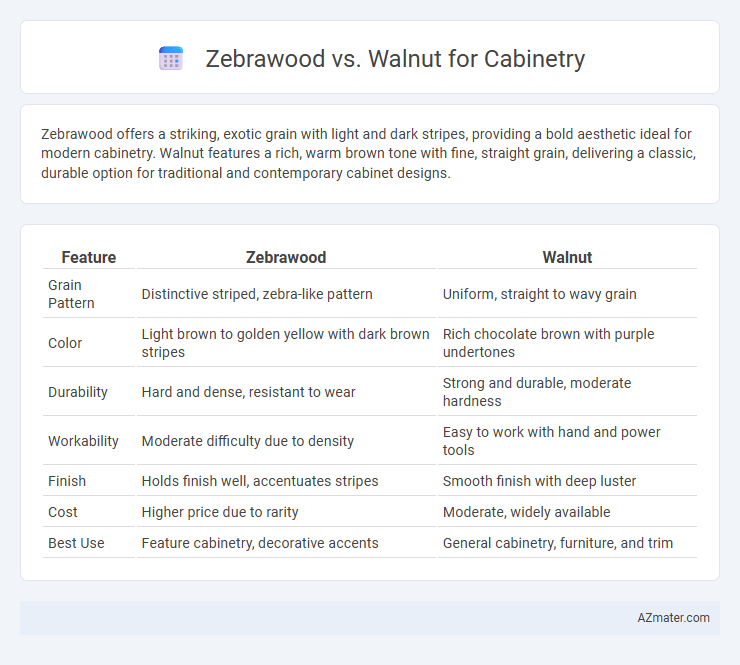Zebrawood offers a striking, exotic grain with light and dark stripes, providing a bold aesthetic ideal for modern cabinetry. Walnut features a rich, warm brown tone with fine, straight grain, delivering a classic, durable option for traditional and contemporary cabinet designs.
Table of Comparison
| Feature | Zebrawood | Walnut |
|---|---|---|
| Grain Pattern | Distinctive striped, zebra-like pattern | Uniform, straight to wavy grain |
| Color | Light brown to golden yellow with dark brown stripes | Rich chocolate brown with purple undertones |
| Durability | Hard and dense, resistant to wear | Strong and durable, moderate hardness |
| Workability | Moderate difficulty due to density | Easy to work with hand and power tools |
| Finish | Holds finish well, accentuates stripes | Smooth finish with deep luster |
| Cost | Higher price due to rarity | Moderate, widely available |
| Best Use | Feature cabinetry, decorative accents | General cabinetry, furniture, and trim |
Introduction to Zebrawood and Walnut
Zebrawood, known for its striking dark and light striped pattern, offers a unique aesthetic that stands out in cabinetry designs. Walnut, prized for its rich, warm brown tones and consistent grain, delivers a classic, elegant appearance highly favored in traditional and modern kitchens. Both woods provide durability and workability, but Zebrawood's bold look contrasts with Walnut's timeless sophistication, influencing the overall style of cabinetry projects.
Visual Appeal: Grain Patterns and Colors
Zebrawood features bold, contrasting dark and light stripes that create a striking, exotic visual appeal in cabinetry. Walnut showcases rich, deep brown tones with a smooth, consistent grain pattern that exudes classic elegance and warmth. The choice between Zebrawood's vibrant, dynamic look and Walnut's refined, timeless finish depends on the desired aesthetic impact in interior design.
Durability and Strength Comparison
Zebrawood offers exceptional hardness and durability, making it highly resistant to dents and scratches in cabinetry applications, with a Janka hardness rating around 1570. Walnut, known for its moderate hardness at approximately 1010 Janka, provides a balance of strength and workability but is more prone to surface wear compared to Zebrawood. For high-traffic cabinetry, Zebrawood's dense grain structure ensures long-lasting performance, whereas Walnut is favored for aesthetic richness despite its relatively softer nature.
Workability and Ease of Crafting
Zebrawood offers moderate workability with its coarse grain and occasional interlocking patterns, requiring sharp tools and patience to achieve smooth finishes for cabinetry. Walnut is prized for its excellent ease of crafting, featuring a consistent, straight grain that sands and cuts cleanly, making it highly suitable for intricate designs and fine detailing. Both woods perform well, but Walnut's superior workability often results in faster production times and a more refined final product for cabinetry projects.
Cost Differences: Zebrawood vs Walnut
Zebrawood typically costs more per board foot compared to walnut due to its exotic nature and limited availability, with prices ranging from $15 to $30, while walnut generally falls between $8 and $15. The higher cost of zebrawood impacts overall cabinetry expenses, making walnut a more budget-friendly option for large projects. However, zebrawood's striking grain pattern justifies the premium for high-end, decorative cabinets.
Maintenance and Longevity
Zebrawood offers striking durability with moderate maintenance, requiring regular cleaning and occasional oiling to maintain its rich grain and prevent drying or cracking. Walnut, known for its longevity, demands less frequent upkeep but benefits from periodic conditioning to preserve its smooth texture and dark, warm tones. Both woods resist wear well, though walnut's tighter grain provides a more resilient surface against dents and scratches in high-use cabinetry.
Environmental Impact and Sustainability
Zebrawood, sourced primarily from West African forests, faces significant sustainability challenges due to overharvesting and habitat loss, leading to stricter trade regulations under CITES. Walnut, commonly harvested in North America and Europe, benefits from more sustainable forestry practices and certifications like FSC, ensuring responsible management and regeneration. Choosing walnut for cabinetry typically results in a lower environmental footprint compared to zebrawood, which demands careful consideration of legal and ecological impacts.
Best Applications in Cabinetry
Zebrawood's distinctive striped grain makes it ideal for accent pieces, decorative panels, and custom cabinetry where bold aesthetics are desired. Walnut offers superior durability and a rich, warm tone that suits traditional kitchen cabinets, high-end furniture, and built-in storage requiring a luxurious yet timeless appearance. Both woods perform well, but Zebrawood excels in visual impact, while Walnut is preferred for lasting strength and classic elegance in cabinetry.
Popular Styles and Design Trends
Zebrawood and walnut are both popular choices for cabinetry, each reflecting distinct design trends. Zebrawood's bold, striped grain adds a striking, exotic look favored in modern and eclectic styles, enhancing rooms with strong visual contrasts. Walnut's rich, warm tones and smooth grain complement traditional, mid-century modern, and contemporary designs, offering timeless elegance and versatility in cabinetry.
Conclusion: Choosing Between Zebrawood and Walnut
Zebrawood offers a bold, exotic look with distinctive striped grain patterns, ideal for statement cabinetry, while walnut provides a classic, rich brown tone with smooth texture, favored for timeless and elegant designs. Durability-wise, both woods perform well, but walnut generally has better resistance to wear and aging, making it suitable for long-lasting kitchen cabinets. Consider design preference and maintenance needs, with zebrawood demanding more care due to its porous nature compared to the relatively low-maintenance walnut.

Infographic: Zebrawood vs Walnut for Cabinetry
 azmater.com
azmater.com